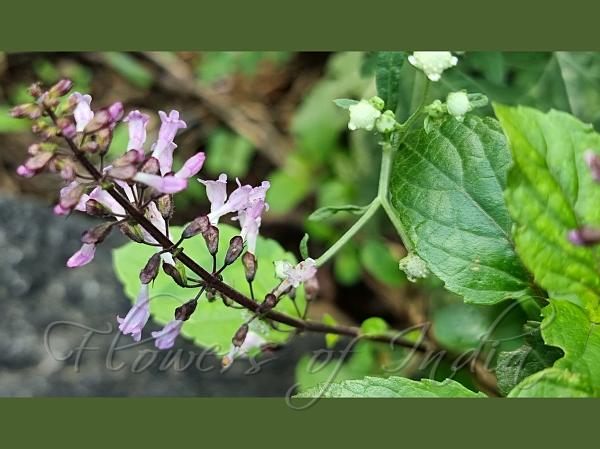|
| Blushred Isodon |
|

|

| File size | 505556 |
| Original date | 5/11/23 8:12 AM |
| Resolution | 4000 x 1800 |
| Flash | Flash did not fire |
| Focal length | 6.7mm |
| Exposure time | 1/138s |
| Aperture | 1.8 |
| Focus Distance | |
| Metering Mode | Center weighted average |
| Camera make | samsung |
| Camera model | SM-G998B |
| Sensor type |
|
|
|
|
Photo: |
Botanical name: Isodon rubescens Family: Lamiaceae (Mint family)
Synonyms: Rabdosia rubescens, Plectranthus rubescens, Isodon ricinispermus
Synonyms: Rabdosia rubescens, Plectranthus rubescens, Isodon ricinispermus
Blushred Isodon is a shrub 50-100 cm. Flowers are
light purple 7-12 mm, sometimes about 5 mm in pistillate flowers,
velvet-hairy, glandular, tube 3.5-5 mm. Flowers are two-lipped, the
upper lip having four clefts that are recurved, the lower lip being
entire and concave. Stamens and style protrude out. Sepal-cup is
bell-shaped, 2.5-3 mm, densely gray velvet-hairy, glandular,
prominently reddish, 10-veined, slightly 2-lipped; teeth
ovate-triangular, about 1/2 as long as sepal-cup; fruiting sepal-cup
dilated, 4-5 mm, tubular-bell-shaped, slightly curved. Flowers are
borne in panicles at branch-ends, narrow, 6-15 cm, densely
velvet-hairy; cymes stalked, 3-5-flowered. Floral leaves are gradually
reduced toward tip, mostly shorter than cymes. Stems numerous, erect,
brownish gray, hairless, much branched at tip; branchlets reddish,
densely woolly. Leaf-stalks are 1-3.5 cm; leaf blade ovate to
rhombic-ovate, 2-6 x 1.3-3 cm, membranous to papery, base broadly
wedge-shaped, margin coarsely rounded toothed-sawtoothed, tip pointed
to tapering; lateral veins 3- or 4-paired, reddish. Nutlets are
brownish, triquetrous, ovoid, about 1.3 mm, hairless. Flowering:
July-October.
Medicinal uses: The basic method for dried
herbs and flower is, take 2-3 tablespoons of dried herb in a cup or
teapot. Pour hot water over it and cover it with lid for 10-30 minutes.
Hot water is needed to draw out the antioxidants, enzymes, vitamins,
flavonoids and volatile oils from the botanicals. Strain and squeeze
out as much as liquid as possible and consume.
The basic method for dried
herbs and flower is, take 2-3 tablespoons of dried herb in a cup or
teapot. Pour hot water over it and cover it with lid for 10-30 minutes.
Hot water is needed to draw out the antioxidants, enzymes, vitamins,
flavonoids and volatile oils from the botanicals. Strain and squeeze
out as much as liquid as possible and consume.
Medicinal uses:
 The basic method for dried
herbs and flower is, take 2-3 tablespoons of dried herb in a cup or
teapot. Pour hot water over it and cover it with lid for 10-30 minutes.
Hot water is needed to draw out the antioxidants, enzymes, vitamins,
flavonoids and volatile oils from the botanicals. Strain and squeeze
out as much as liquid as possible and consume.
The basic method for dried
herbs and flower is, take 2-3 tablespoons of dried herb in a cup or
teapot. Pour hot water over it and cover it with lid for 10-30 minutes.
Hot water is needed to draw out the antioxidants, enzymes, vitamins,
flavonoids and volatile oils from the botanicals. Strain and squeeze
out as much as liquid as possible and consume. | Identification credit: Manjula Sridhar | Photographed in cultivation in Tamil Nadu. |
• Is this flower misidentified? If yes,